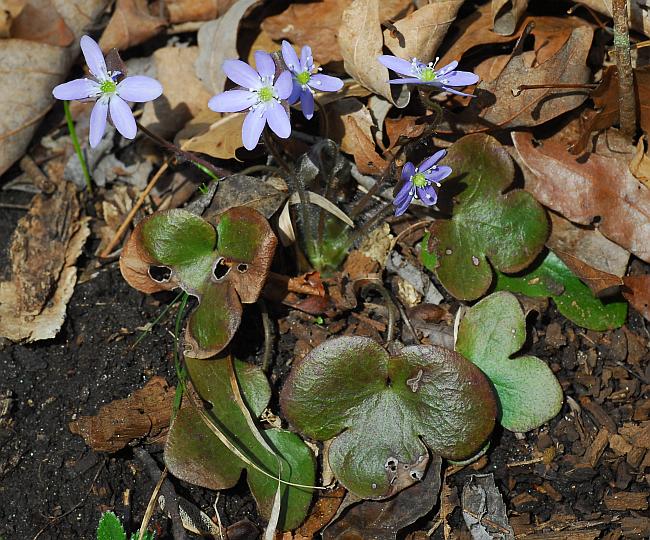Hepatica americana (DC.) Ker Gawl.
Round-Lobed Hepatica

Native
CC = 6
CW = 5
MOC = 20
© SRTurner
Hepatica americana (DC.) Ker Gawl.Round-Lobed Hepatica | |
 |
Native CC = 6 CW = 5 MOC = 20 |
© SRTurner |
|
Family - Ranunculaceae Habit - Rhizomatous perennial forb.
Stems - Scapose, 5-15 cm long, unbranched, usually densely hairy.
Leaves - Basal leaves 2-13, usually darkened to maroon or dark purple at flowering, sometimes absent, densely long-pilose beneath when young but becoming glabrate with age, the blades 3-lobed for 30-50% of their length, the lobes 18-31 mm wide, rounded at the tip, the margins entire.
Inflorescence - Flowers solitary on stems, each subtended by 3 involucral bracts, these sessile, elliptic to ovate, rounded or broadly and bluntly pointed at the tip, densely hairy, the margins entire.
Flowers - Actinomorphic, perfect. Sepals petaloid, usually 5 or 6, 7-13 mm long, white, pink, or pale blue, deciduous. Petals absent. Head of fruits 4-6 mm long, 7-10 mm in diameter, hemispherical.
Fruits - Achenes, elliptic in outline, sparsely to moderately pubescent with straight hairs not concealing the surface, the beak 0.5-1.0 mm long, brittle and often broken off. Receptacle not enlarged at fruiting. Flowering - February - April. Habitat - Forests, bluffs, rock outcrops, often on acidic substrate. Origin - Native to the U.S. Lookalikes - H. acutiloba. Other info. - This is one of the most delicate and beautiful of the springtime ephemeral wildflowers. In Missouri it is found within a well-defined cluster in the Ozarks. That range extends into Arkansas but is otherwise disjunct from other populations found in the continental U.S. These form a crescent beginning in Minnesota, extending into the northeastern U.S. and Canada, and down into Alabama. Photographs taken at Shaw Nature Reserve, Franklin County, MO, 4-1-2014, Poison Hollow, Howell County, MO, 5-14-2019, and Carman Springs Natural Area, Howell County, MO, 5-14-2019 (SRTurner). |